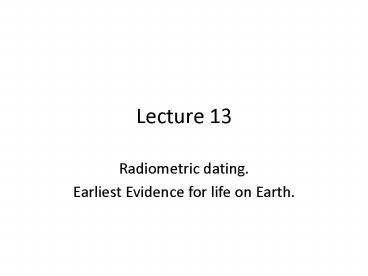Radiometric dating. PowerPoint PPT Presentation
1 / 25
Title: Radiometric dating.
1
Lecture 13
- Radiometric dating.
- Earliest Evidence for life on Earth.
2
Student Presentations
- Matthew Trice and Samantha . Life on Europa
October 23 - Connie Kwong et al. Permian Triassic extinction
October 28 - Kelsey Palmer and Lyndsey Mullens Asteroids and
Comets and their implication to the origin of
life October 30 - Michael Barnett et al. Life on Mars
November 4 - Triana Henz Planetary terraforming
November 6
3
Radioactive isotopes (238U, 14C) can
spontaneously change or decay
4
Radiometric dating
- Radiometric dating is a technique used to date
materials, based on a comparison between the
observed abundance of particular naturally
occurring radioactive isotopes and their known
decay rates. - Initial radioactive isotope is called a parent
and the product of decay is called a daughter. - The half-life time of an isotope is the interval
of time required for an isotope to decay to half
of its initial amount.
5
(No Transcript)
6
Typical Parent-Daughter pairs used in
radiometric dating
7
Potassium-Argon dating
- Argon is a gas and therefore if a rock was melted
then Ar escapes. - Any 40Ar in the rock has to come from the decay
of 40K after rock became solid. - So by measuring 40K and 40Ar in the same rock we
can find the age of that rock
8
Uranium-Lead dating
- Usually performed on zircon (ZrSiO4)
- Zircons can incorporate uranium (238U) into its
crystalline structure when they form but reject
lead - Any lead (206Pb) observed in zircons has to come
from the decay of uranium - which was already incorporated
- into zircons
9
Problems with radiometric dating
- System has to remain closed no input of
parent isotopes and no escape for daughter
product - Cannot perform radiometric dating on the
sedimentary rocks
10
Challenges for life detection in the ancient rocks
- Ancient rocks are rare (burial, erosion,
subduction, ejection into space during late heavy
bombardment) - Survived rocks are changed by metamorphism
(pressure and heat) - No bones or shells! Single-celled prokaryotic
organisms - Not every rock can contain evidence for life (no
life in the igneous rocks) - Contamination
11
Locations of the exposed ancient rocks
- Akilia (SW Greenland) gt 3.85 Gyr ago
- Isua (W Greenland) 3.7-3.8 Gyr ago
- Pilbara (NW Australia) 3.52 Gyr ago
- Swaziland (South Africa) 3.5 Gyr ago
12
(No Transcript)
13
Carbon Isotopes
- On Earth 13C/12C 1/90
- Standard (Pee Dee Belemnite) 13C/12C 0.01123722
- A typical 13C/12C ratio in a living organism
0.0109563 - ?13C 1000((13C/12C)sample -(13C/12C)standard)/(
13C/12C)standard - in parts per thousand (or per mil)
- During photosynthesis organic carbon becomes
enriched in 12C
14
(No Transcript)
15
?13C 1000((13C/12C)sample (13C/12C)standard)/
(13C/12C)standard ?13C very small in organic
matter gt organic matter has to be from the
biosphere
16
Challenge!
- Organic matter in the Akilia rocks could have
been produced without life through thermal
disproportionation - 6 FeCO3 ? 2Fe3O4 5 CO2 C
- Akilia rocks might not be sedimentary
- Possible presentation Fedo and Whitehouse
(2002) Science 296 1448-1452
17
Carbon isotopes in the ancient rocks
- The overall pre-1 Gyr old carbon isotope record
is similar to the carbon isotope record of the
modern times. - Autotrophic organism were likely to be present
since at least 3.5 Gyr ago.
18
Microfossils
- Microfossils are the preserved remains of
microbial organisms - Small! Up to a few tens of microns. Either simple
spheroids (balls) or simple filaments
(sticks) - See the debate between Brasier et al. (2002),
Nature 416 p. 76-81 and Schopf et al. (2002),
Nature 416 p. 73-76
19
3.5 Gyr old microfossils Under debate!
20
Stromatolites fossilized remains of the
ancient bacterial mat
21
Stromatolites
- Stromatolites are laminated sedimentary
structures - If stromatolites are biogenic then they represent
fossils of colonial photosynthesizing microbes
(cyanobacteria) which built reefs similar to
corals today - The most ancient biological stromatolite is
3.46 Gyr old (Warrawoona, Australia)
22
Biomarkers
- Certain hydrocarbon molecules found in the
ancient organic matter are recognizable
derivatives of biological molecules - When these molecules have a specific biological
source they are called biomarkers - Biomarkers of eukaryotes and cyanobacteria were
found in 2.5-2.7 Gyr old rocks (Hamersly,
Australia)
23
(No Transcript)
24
(No Transcript)
25
(No Transcript)

